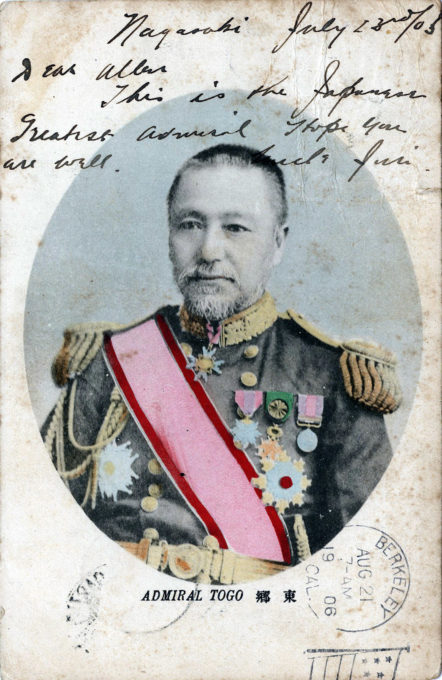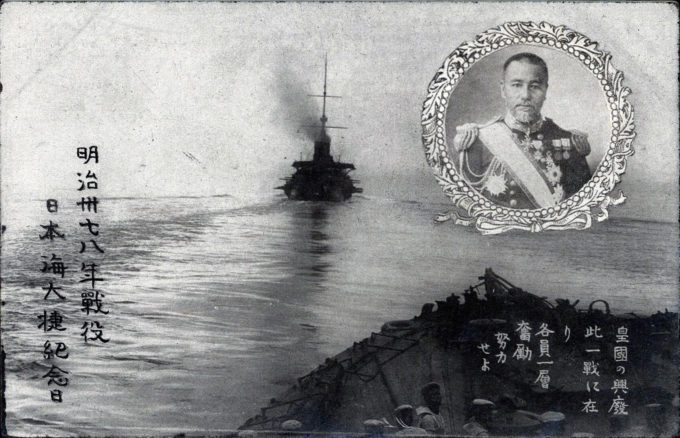
“This is the Japanese greatest admiral …” Admiral Togo, 1906, gensu [Admiral] of the fleet of the Imperial Japanese Navy, and one of Japan’s greatest naval heroes. During the Russo-Japanese War of 1904–1905, he successfully confined the Russian Pacific naval forces to Port Arthur before winning a decisive victory over a relieving Russian Baltic Fleet fleet at Tsushima in May 1905. Western journalists called Tōgō ‘the Nelson of the East’.
See also:
Russo-Japanese War (1904-1905).
IJN battleship “Mikasa”, c. 1910.
Emperor Meiji at the Grand Fleet Review, 1905.
“The modest and retiring life which Admiral Togo has hitherto lived has made it difficult for the biographer to collect many picturesque incidents relating to his early years. But modesty is one of the greatest of virtues, and that he has always exhibited this virtue in so conspicuous a manner seems to be one of the elements which make the greatness of his character.
“Togo Heihachiro was born in Kajiya-machi, the Samurai quarter of Kagoshima, on the 22nd of December, 1847.
“His family was descended from the ancient family of the Taira, which played so great a part in the Middle Ages of Japan. The last and, indeed, the only sage of the Taira family, Taira no Shigemori, had an only daughter, who, on the ruin of her house, being pursued by her enemy, the head of the rival Minamoto family, found an asylum in the territories of the Prince of Satsuma. Here she remained, educating her children, who, growing up, entered the service of the Satsuma Daimyo and were granted the surname of Togo.
“… In 1863, at the age of seventeen, Togo entered the Satsuma Navy, as a cadet. [But his employment came to an end when the] Satsuma Navy ceased to exist with the restoration of the Imperial Power in 1868, which brought all military and naval forces under the control of the newly-formed central government, and the Imperial Navy had not yet been founded.
“Still his heart remained in the naval profession, and the experiences of the Hakodate campaign having been quite long enough to let him know the imperfections of Japanese seamanship, his own included, he made application through the leading men of his clan to be sent to England for purposes of study.
Battleship Mikasa and fleet admiral Togo (inset photo), 1905, leading the Japanese line of battle against the Russian fleet at the Battle of Tsushima, the first decisive sea battle fought by modern steel battleship fleets. “Being in the Empire’s world war, let each member work harder. In the 38th year of Meiji, the great victory of Japan.”
“… In London, he met several of his compatriots, Satsuma and Choshu clansmen, such as Kawase, Kawakita, and others who were studying like himself. Kikuchi Dairoku, now a Baron, and for some time a Minister of Education, was then either in London, or in Cambridge, and a few others from other parts of Japan were there to form a body round which all the Japanese students in England might from time to time rally. Togo did not want for companions in London, but circumstances eventually led him to Plymouth, to the training-ship Worcester, which seemed to offer him the greatest facilities for obtaining a practical mastery of the details of his profession.
“The reports sent home about him were so good that in 1872 the Government decided to grant him the rank and treatment of a 2nd Lieutenant in the Imperial Navy, which had been reconstructed since his departure for England, and when his course of training on board the Worcester was finished, in 1876, he was ordered to remain in England to watch the construction of the new Japanese ship Hiei, which was finished in January 1878, and reached Japan in the following May. [The Hiei was a Kongō-class ironclad corvette built in the United Kingdom because the Japanese were not yet able to construct ironclad warships at the time in Japan. ]
“… Lieutenant Togo returned to Japan on board the newly-christened Hiei, on May 2, 1878, and on the 3d of July following was promoted to the rank of 2nd Lieutenant (chu-i). On the 18th of August, he was transferred to the Fuso, and on the 18th December received another step, being promoted a full Lieutenant (tai-i). The rapidity of his promotion may be taken as some indication of the esteem in which he was held by his superiors.”
– The Life of Admiral Togo, by Arthur Lloyd, M.A., 1905


